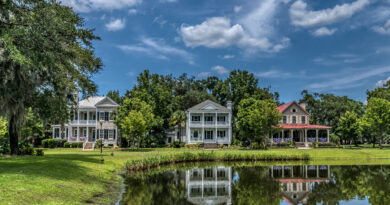Knee Deep In Tomatoes
The Sanders family has kept the farming tradition on Saint Helena Island alive for well over a century.
story by cindy reid photography by paul nurnberg
As you head out toward the beach, stop in Macdonald MarketPlace in Frogmore on Saint Helena Island. The building which was originally a general store, post office, and boarding house, was recently purchased and refurbished by the Sanders family. It had been built by their great-grandfather, James Ross Macdonald, in 1877. There have been several incarnations in the intervening years and now the Sanders vision is a center for “uniting local artisans in one collective space”.
Caroline, Lea, Grey, Mac, with their respective spouses Bill Hatcher, Jimmy Taylor, Fran Hightower Sanders and Sharon Fletcher Sanders, along with their children, and their mother, Martha, are all involved and have have stories to tell about their history on St. Helena Island and in particular, on Seaside Farm.
When this building became available, the Sanders were happy to buy it because of the proximity to their two tomato packing houses that stand practically across the street from each other. It’s a wonderful building and the renovations they have undertaken are striking. All the old floors and floor joists were removed and refinished and are now the main flooring. Four inches of concrete had to be poured around the piers to stabilize the flooring. Five chimneys on the second floor, and all the plaster upstairs, had to be removed because of the weight; the bricks from those chimneys were used to make the exterior walkways.
The interior is an architectural delight; there are nooks and crannies and lots of light; dividers are made of tomato stakes from the farm, the old iron bars are still on some of the windows. The charm is abundant and serves well for the eclectic collection of consigned artisanal wares for sale – handmade items such as furniture, lampshades, jewelry, art, pottery, rugs. All the artists are local, or have a local connection. One small room has coolers of ready made food items, a small building on the back deck houses some exotic plants. In one of the rooms where fresh produce is sold when available, are old photographs that have been enlarged which exhibit activities in the packing houses back in the day.
Saint Helena Island has a history rich in agriculture. In the early 1700’s, cattle grazing and mixed farming were the major agricultural activities. By the mid-1700’s, indigo became the important crop, but after the Revolutionary War the indigo market was destroyed. Then the famous Sea Island cotton came in as the new cash crop. All the while, the plantations on Saint Helena had diverse farming. In those days, with a single dirt road, no bridges, and two bodies of water to cross to even get into Beaufort, travel for supplies took long hours, or even days, depending on the tides and conditions.
Since the climate borders on temperate to tropical, crops that have been grown on Saint Helena include citrus, figs, pomegranates, peaches, strawberries, corn, apples, wheat, sugarcane, flax, potatoes, watermelons, tomatoes, cucumbers, and other vegetables. It’s a difficult, mercurial business, subject to the whims of things over which there is no control, the foremost of which is weather.
In the time honored agricultural customs on Saint Helena Island, the Sanders family has kept the farming tradition alive for well over a century. As a matter of fact, Gus Sanders, who was the father of Martha’s late husband, Ross, grew the first tomatoes in Beaufort County. Now, the Sanders produce between 15 and 20 million pounds of tomatoes a year! This family had been knee deep in tomatoes all their lives. They grew up working in the fields, and the packing plants. Lea began stamping the boxes when she was ten, Caroline started working in the packing house when she was nine. Also at a young age, Mac and Grey started driving the tractors and changing the irrigation pipes all night long. Everyone did their share.
When you see truckloads of green tomatoes come rolling down the roads in June, and then the open busloads of watermelons appear later in the season, it’s difficult to imagine where all that produce comes from unless you have ventured down Lands End Road or Seaside Road and seen the vast acreage in fields.
It takes 600 acres of land to net 400 acres in tomatoes, and this is how it happens. In September and October, the Sanders start getting ready. In November plastic is put down over drip tubes; the plastic reflects the light to keep the insects away so there is less need for bug spray. Tomato seeds are ordered and sent to seed planting houses where the plants start to grow. Those plants are shipped to the farm and get planted between March 8 and April 12. The first crop takes 88 – 90 days to mature; the second crop takes about 77 days, due to increased temperature and sunlight. The tomatoes are harvested beginning on June 5, but the workers arrive on June 1 because the weather may be a factor. 300 people work in the fields picking and 150 work in the packing houses. When the tomatoes are picked they are put in 35 pound buckets which are placed in bins and loaded onto a truck that will then take the 1000 pound load to the packing house. There they will be sorted by size, color and grade. Although the tomatoes are all picked green, because handling ripe red tomatoes isn’t feasible, they are placed in a cooling room where they will turn pink before they are shipped. The buyers like to dictate the color of their tomatoes, and all of the tomatoes are shipped for fresh markets; none go to processing plants. 600,000 to 800,000 twenty-five pound boxes of the tomatoes are shipped all over the country, as well as to Puerto Rico and Canada. The tomatoes that don’t make the grade in the packing houses are sent back to the farm and plowed under in the fields.
There is an average of 21 harvest days of picking and afterwards the plants are untied, the stakes are pulled (and reused), the plastic that isn’t going to be used for the next 150 acre crop of watermelons is removed and the remains of the tomatoes are moved from the fields.
When tomatoes are ripe, everyone thinks of their favorite recipe – tomato pie, tomato soup, canned tomatoes put away for the winter. A slice of tomato on a piece of bread with a swipe of mayo is as close to nirvana as most foodies can get, but even a fresh bite of a tomato, dripping juices, eaten with just your fingers, can’t be beat. And both Lea and Caroline agree, Lea’s favorite “recipe” is a tomato sandwich and Caroline thinks hers may be tomatoes and okra. They remember that as children, they were raised to order tomatoes when they went to restaurants in support of the industry.
Although the farm had been in the family for decades, this generation took footing when Martha Graham Sanders’ journey toward the farm began. Her father was the county agent for Ridgeland and the manager of Turkey Hill Plantation; when he died, her mother moved to Beaufort. Martha was working at People’s Bank when she met Ross Macdonald Sanders at a party. Apparently he had noticed her prior to the party, and had his eye on her. She says, “He was a very, very special man.”
The family reminisces and banters about growing up. Martha recalls, “There was no one out here but us; the road from the house to the farm was dirt, and my husband worked all the time.” Lea: We had a curfew, the boys didn’t have to be in until midnight, but I had to be home by eleven. Grey: (tongue in cheek) I never stayed out that late. Caroline: I would be lying in bed sound asleep when all of a sudden I was soaking wet and I couldn’t understand why the rain had come into my room. We didn’t have air conditioning so we slept with the windows open. When Mac and Grey came in late and didn’t want to wake up our parents, they turned on the hose and sprayed it on my bed so I would get up and open the door; they drenched me more than once. (G: Pretends he didn’t hear her say that.) L: When mother answered the phone and I asked her to say I wasn’t at home because I didn’t want to talk to someone, she made me go sit outside on the step so that I really wasn’t in the house. C: Friends came to the farm and they would be so surprised when I would pick a tomato or ear of corn and eat it right in the field.
Grey and Mac remember when they would pack up and go out to the fish camps in the summer. With the river in their front yard, they all have stories of learning to sail or boat, fishing, swimming.
The Sanders grew up in a place and time that shaped character and values; they worked hard on the farm which has kept them close and still working together. Although Macdonald MarketPlace is a new adventure, and one that they didn’t quite envision when they bought the building, they are having fun. Make sure you visit and experience a bit of their part of the important history of the island.



